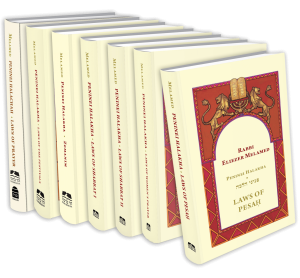Le-khatḥila, one should blow in the order mandated by the Sages: three sets of tashrat, three sets of tashat, and three sets of tarat. Be-di’avad, one who changes the order still fulfills his obligation. For example, if he blows two sets of tashrat and then goes on to blow three sets each of tashat and tarat, he can later make up the last tashrat (SA 590:9; MB ad loc. 35).
If one makes a mistake blowing a blast, sometimes it is sufficient to simply repeat the blast. Other times the entire set of three blasts – tashrat, tashat, or tarat – must be repeated. It is never necessary to repeat an entire series of three sets, as each set stands on its own.
Within each set, the shofar-blower must take a break long enough to breathe between each teki’a and the adjacent shevarim or teru’a, and vice versa. Since the teki’a expresses joy and peace, while the teru’a expresses crying and sighing, it is proper to separate them (Levush). If the shofar-blower did not make this minimal pause between them, some say that he nevertheless fulfills his obligation, while others say that he does not. Even though the lenient position is accepted, for the first thirty blasts it is proper to be stringent and return to the first teki’a of that set (SA 590:5; SAH ad loc. 9).[16]
Each shevarim and each teru’a must be continuous. If the shofar-blower was confused and stopped for long enough to take a breath while in the middle of a shevarim or teru’a, he has not fulfilled the obligation, as he has split the blast into two distinct parts. Therefore, he must repeat it (MB 590:16; SHT ad loc. 14).[17]
The Rishonim disagree about the shevarim-teru’a in tashrat. Many maintain that it must be blown in one breath, as they are a single mitzva. Since shevarim-teru’a may be the teru’a referred to by the Torah, one may not interrupt it by breathing in the middle – and if he did, he does not fulfill the obligation. However, he should pause slightly between them, to separate the two parts of the blast (R. Yitzḥak ibn Gi’at; Rosh; Rashba; Ran; Rivash; Beit Yosef; MB ad loc. 18). Others maintain that le-khatḥila he must take a breath between them, as people breathe while sighing or sobbing (Rabbeinu Tam). However, if he does not take a breath, all agree that he fulfills his obligation be-di’avad. To fulfill every view, the custom is that for the teki’ot before Musaf, the shofar-blower does not breathe between the shevarim and teru’a, but for the thirty teki’ot during the Amida, he does (SA 590:4; SHT ad loc. 18).
[17]. According to most poskim – Rishonim and Aḥaronim – if he paused to breathe in the middle of a shevarim or teru’a, he has not fulfilled the obligation, as explained in SHT 590:14. However, some are lenient (Taz; MA).

